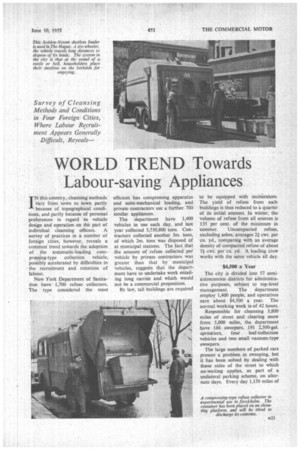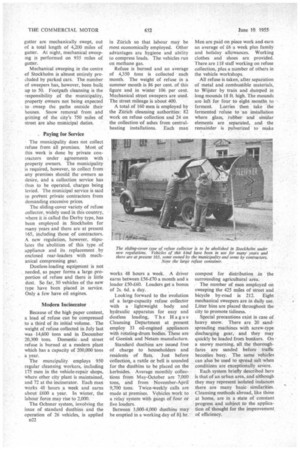WORLD TREND Towards Labour-saving Appliances
Page 87

Page 88

If you've noticed an error in this article please click here to report it so we can fix it.
Survey of Cleansing Methods and Conditions in Four Foreign Cities, Where Labour Recruitment Appears Generally Difficult, Reveals
IN this country, cleansing methods Vary from town to town partly because of topographical conditions, and partly because of personal preferences in regard to vehicle design and operation on the part of individual cleansing officers. A survey of practices in a number of foreign cities, however, reveals a common trend towards the adoption of the automatic-loading compressing-type collection vehicle, possibly accelerated by difficulties in the recruitment and retention of labour.
New York Department of Sanitation have 1,700 refuse collectors. The type considered the most efficient has compressing apparatus and semi-mechanical loading, and private contractors use a further 700 similar appliances.
The department have 1,400 vehicles in use each day, and last year collected 3,530,800 tons. Contractors collected another 3m. tons, of which 2m. tons was disposed of at municipal stations. The fact that the amount of refuse collected per vehicle by private contractors was greater than that by municipal vehicles, suggests that the department have to undertake work entailing long carries and which would not be a commercial proposition.
By law, tall buildings are required to be equipped with incinerators. The yield of refuse from such buildings is thus reduced to a quarter of its initial amount. In winter, the volume of refuse from all sources is 135 per cent. of the minimum in summer. Uncompacted refuse, excluding ashes, averages 21 cwt. per cu. yd., comparing with an average density of compacted refuse of about 3f cwt. per cu. yd. A loading crew works with the same vehicle all day.
$4,500 a Year
The city is divided into 57 semiautonomous districts for administrative purposes, subject to top-level management. The department employ 1,409 people, and operatives earn about 14,500 a year. The normal working week is of 42 hours.
Responsible for cleansing 3,800 miles of street and clearing snow from 5,800 miles, the department have 186 sweepers, 191 2,500-gal. sprinklers, four leaf-collection vehicles arid two small vacuum-type sweepers.
The large numbers of parked cars present a problem in sweeping, but it has been solved by dealing with those sides of the street to which no-waiting applies, as part of a unilateral parking scheme, on alternate days. Every day 1,150 miles of gutter are mechanically swept, out of a total length of 4,200 miles of gutter. At night, mechanical sweeping is performed on 935 miles of gutter.
Mechanical sweeping in the centre of Stockholm is almost entirely precluded by parked cars. The number of sweepers has, however, been built up to 50. Footpath cleansing is the responsibility of the municipality, property owners not being expected to sweep the paths outside their houses. Snow removal from and gritting of the city's 750 miles of street are also municipal duties.
. Paying for Service The municipality does not collect refuse from all premises. Most of this work is done by private contractors under agreements with property owners, The municipality is required, however, to collect from any premises should the owners so desire, and a collection service has thus to be operated, charges being levied. The municipal service is said to prevent private contractors from demanding excessive prices.
The sliding-cover variety of refuse collector, widely used in this country, where it is called the Derby type, has been employed in Stockholm for many years and there are at present 165, including those of contractors. A new regulation, however, stipulates the abolition of this type of appliance and its replacement by enclosed rear-loaders with mechanical compressing gear.
Dustless-loading equipment is not needed, as paper forms a large proportion of refuse and there is little dust. So far, 30 vehicles of the new type have been placed in service. Only a few have oil engines.
Modern Incinerator Because of the high paper content, a load of refuse can be compressed to a third of its initial volume. The weight of refuse collected in July last was 14,600 tons and in December 20,300 tons. Domestie and street refuse is burned at a modern plant which has a capacity of 200,000 tons a year.
The mon eipality employs 950 regular cleansing workers, including 175 men in the vehicle-repair shops, where other city plant is maintained, and 72 at the incinerator. Each man works 48 hours a week and earns about £600 a year. In winter, the labour force may rise to 2,000.
The Ochsner system, involving the issue of standard dustbins and the operation of 26 vehicles, is applied D22 in Ztirich so that labour may be most economically employed. Other advantages are hygiene and ability to compress loads. The vehicles run on methane gas.
Refuse is burned and an average • of 4,350 tons is collected each month. The weight of refuse in a summer month is 86 per cent, of this figure and in winter 106 per cent. Mechanical street sweepers are used. The street mileage is about 400.
A total of 160 men is employed by the Z.('rich cleansing authorities: 82 work on refuse collection and 24 on the collection 'of ashes from centralheating installations. Each man works 48 hours a week. A driver earns between £56-170 a month and a loader L50-£60. Loaders get a bonus of 2s. 6d. a day.
Looking forward to the evolution of a large-capacity refuse collector with a lightweight body and hydraulic apparatus for easy and dustless loading, The Hague Cleansing Department at present employ 33 oil-engined appliances with rotating-drum bodies. These are of Geesink and Netam manufacture.
Standard dustbins are issued free of charge to householders and residents of fiats. Just before collection, a rattle or bell is sounded for the dustbins to be placed on the kerbsides. Average monthly collections from May-October are 7,000 tons, and from November-April 9,700 tons. Twice-weekly calls are made at premises. Vehicles work to a relay system with gangs of four or five loaders.
Between 3,000-4,000 dustbins may be emptied in a working day of 81 hr. Men are paid on piece work and earn an average of a a week plus family and holiday allowances. Working clothes and shoes are provided. There are 118 staff working on refuse collection, plus a number of others in the vehicle workshops.
All refuse is taken, after separation of metal and combustible materials, to Wijster by train and dumped in long mounds 18 ft. high. The mounds are left for four to eightmonths to ferment. Lorries then take the fermented refuse to an installation where glass, rubber and similar elements are separated, and the remainder is pulverized to Make compost for distribution -in the surrounding agricultural area.
The number of men employed on sweeping the 425 miles of street and. bicycle by-road is 212. Eight mechanical sweepers are in daily use. Litter bins are placed throughout the city to promote tidiness.
Special precautions exist in case of heavy snow. There are 20 sandspreading machines with screw-type discharging gear, and they may quickly be loaded from bunkers. On • a snowy morning, all, the thoroughfares are sanded before traffic beconies busy. The same vehicles can also 'be used to spread salt when conditions are eXceptionally severe.
Each system briefly described here is that of an urban area, and although they may represent isolated instances there are many basic similarities. Cleansing methods abroad, like those at home, are in a state of constant progress and subject to the application of thought for the improvement, of efficiency.




























































































































































